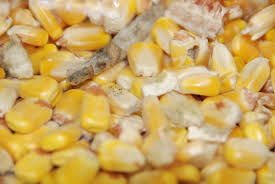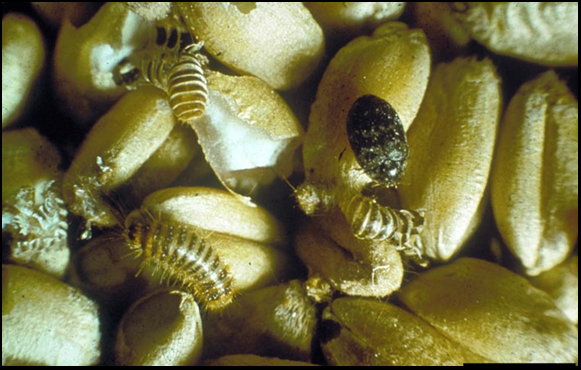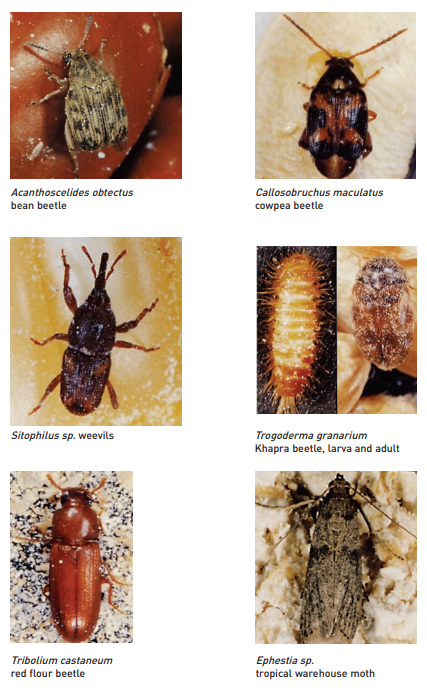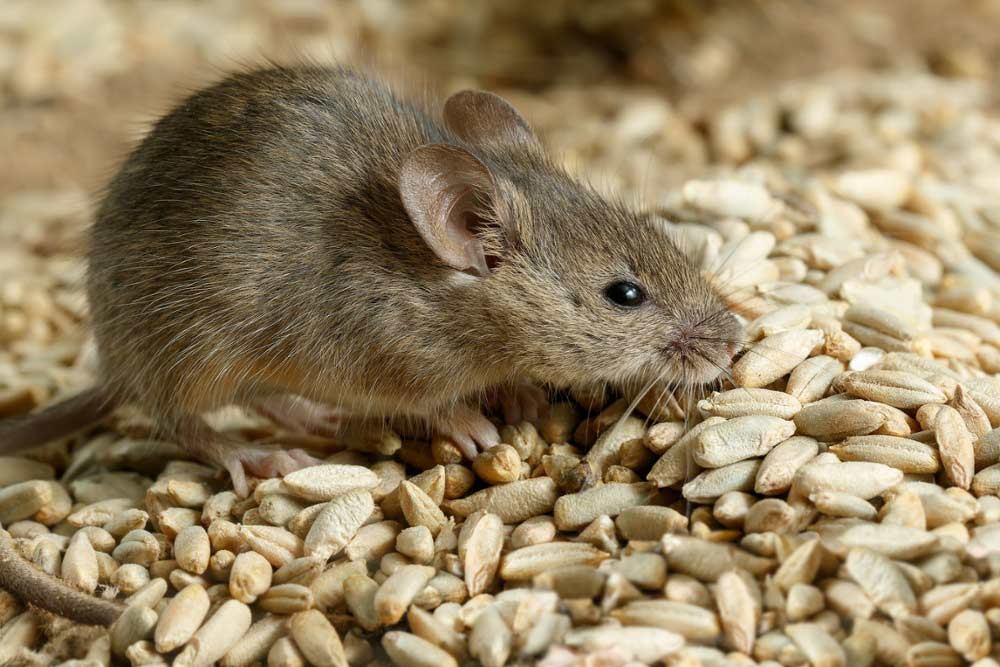Damages of grains or loss of grains vary generally and are a function of crop variety, pest and insects, climate, system of harvesting, system of processing, storage, handling and marketing. The main agents causing deterioration of stored grains are micro-organisms (fungi, bacteria, and yeast/mould), insects and mites, rodents, birds, and metabolic activities.
Fungi
They belong to plant kingdom with no chlorophyll and are therefore, unable to manufacture their own food by photosynthesis. They live on other living things or bodies as parasite, or inactively alive or dead bodies as saprophytes. Parasitic fungi may cause disease in the host body, while saprophytic fungus degrade or destroy the body on which they feed. Saprophytic fungi are more important in relation to stored durable crops.

Bacteria
Bacteria prevalence to the stored durable crops may be low. They may, however, invade already damaged portion of the crop products during storage and their multiplications.
Insects
The term Stored Product Insects or SPI’s, relates to a broad range of pests that can infest a food storage area, the most common of which include weevils, moths, mites and beetles. Specific species include the Rice Grain and Maize Weevils, Confused Flour Beetle, Redrust Beetle, India Meal Moth, Cacao Moth, Tobacco Moth, Warehouse Moth, Mediterranean Flour Moth (or Mill Moth) and Tobacco Beetle.
The type of commodity will determine which insect pests are likely to be present. Whole cereal grains, such as maize, wheat, rice and sorghum will be at risk particularly from weevils, including Sitophilus zeamais and S. oryzae, the maize and rice weevil respectively, and in Africa from the larger grain borer, Prostephanus truncatus. Small grains will also be at risk from the lesser grain borer, Rhyzopertha dominica. Flour beetles such as Tribolium castaneum, the red flour beetle, infest flour and grain products and are generally not associated with entire grain unless it has sustained physical damage and is cracked or split. Moths, including Cadra cautella and Plodia and Ephestia species, also cause problems to milled grain and grain products.

Pulses, beans, cowpea, gram, lentils, etc. are attacked by a group of insects known as bruchids. Unlike the cereal pests, which do not discriminate between host type - the maize weevil will quite happily attack and develop on wheat – bruchids are quite specific in their host range. Acanthoscelides obtectus, the bean beetle, will only develop on the common bean and other members of the Phaseolus family. Callosobruchus maculatus, the cowpea weevil, will develop on cowpea and some grams but not on beans.

The varietal type of the grain will also influence quality maintenance. Some varieties are much more susceptible to insect pests than others. Many soft hybrid maize varieties are extremely susceptible to insects and could lose up to 25% of their weight in just a few months in store if they are not protected with insecticides. Other maize varieties, especially those that originate through lines grown traditionally by farmers may well be relatively resistant to insect pests and only lose 1-2% by weight in a six-month period in store. Furthermore, grain that is unthreshed, such as paddy rice and groundnut in shell, is much less susceptible to insects than threshed grain, white or brown rice and groundnut kernels or redskins.

Insects penetrate the kernels and feed on the surfaces and the endosperm. They remove selectively the nutritious part of the food and encourage the development of bacteria and increase the moisture content of the food. Insect infestation will eventually lead to other storage problems. They give off moisture which can cause grain moisture contents to increase enough to create a mould problem. Mould activity will in turn raise temperatures and result in an increased rate of insect reproduction. Greater numbers of insects create more moisture, and the cycle is repeated at an ever-increasing rate. Insects also cause quality deterioration through their excreta as they consume. Insects are generally not a problem in grain stored for less than 10 months or a year if the grain is at its safe moisture and low temperature of storage.
Rodents
Three species of rodents are major pest of stored products:
- Rattus rattus (Black rat)
- Rattus norvegieus (Brown rat)
- Mus musculus (House mouse)

Rodents consume cereal crops and damage sacks and building structures. They contaminate much great portion of the grain with their urine and droppings than they consume. Rodents can daily consume about 10% of their body weight. Poisoning and preventing their access to stored commodities can control them. Biological control can also be applied to stop rat damages. Generally, rats transmit diseases (typhus, rabies, trichomaisis) and destroy and damage building structures. Regardless of storage period, grain pests can invade the stored grain and affect the quantity and its quality.
Birds
Like rodents, birds also consume some grain foods but also contaminate a greater quantity with droppings. Losses caused by birds can be avoided by preventing their access to the stored commodities.